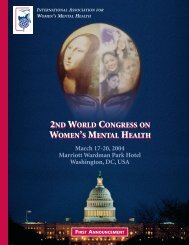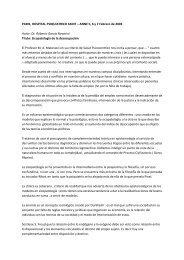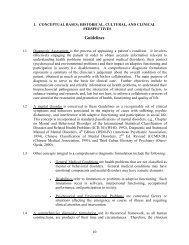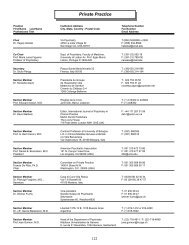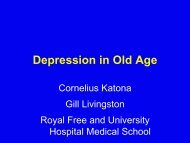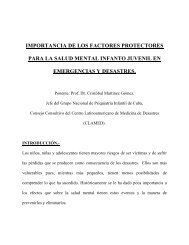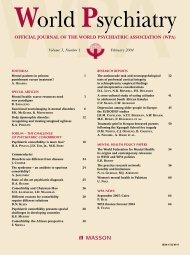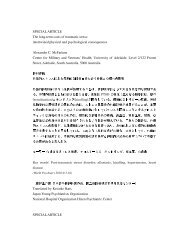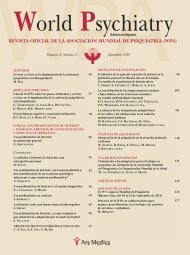ABSTRACTS - World Psychiatric Association
ABSTRACTS - World Psychiatric Association
ABSTRACTS - World Psychiatric Association
Create successful ePaper yourself
Turn your PDF publications into a flip-book with our unique Google optimized e-Paper software.
the actual effects of mass disasters. We propose basic principles to<br />
guide the integration of mental health professionals with other social<br />
agents active in the community, and underscore the importance of<br />
empowering mediators in the process of community recovery after<br />
disaster. Finally, we describe a teacher-mediated model of post-disaster<br />
clinical intervention in schools, which focused on the psychological<br />
reactivation of students and teachers.<br />
RS11.3.<br />
PROTECTIVE FACTORS IN LONG-TERM OUTCOME<br />
FOLLOWING A DISASTER IN CHILDHOOD<br />
A.C. McFarlane<br />
University of Adelaide Node, Centre of Military and Veterans<br />
Health, Adelaide, Australia<br />
In a longitudinal study of 1,014 individuals who were exposed to a<br />
major bushfire disaster in childhood, the role of protective factors in<br />
adult mental health outcomes was explored. Within this cohort and<br />
the comparison group, there were large numbers of individuals<br />
exposed to traumatic events other than the disaster. By comparing<br />
individuals who had high levels of trauma exposure who did and did<br />
not develop post-traumatic stress disorder, a series of indices of<br />
resilience were identified, including patterns of childhood behaviour<br />
and attachment behaviours in the family environment.<br />
RS11.4.<br />
RISK AND PROTECTIVE FACTORS<br />
IN DEVELOPMENT OF POST-TRAUMATIC STRESS<br />
DISORDER<br />
Y. Yazgan<br />
Marmara University, Istanbul, Turkey; Yale Child Study Center,<br />
New Haven, CT, USA<br />
Environmental (e.g., degree of exposure, mother’s responses) and personal<br />
(e.g., past trauma, previous functioning) factors may influence<br />
the child’s long-term response to a trauma, either “man-made” or<br />
“natural”. For example, more severe symptoms following exposure to<br />
a missile attack were associated with physical displacement, living in<br />
a family with inadequate cohesion, and having a mother with poor<br />
psychological functioning. Family factors have received a well<br />
deserved attention in data based and observational studies of Turkish<br />
earthquakes. Parental somatization was identified as a predictor of<br />
acute child distress, accounting for 11.2% of the total variance. A significant<br />
relation was demonstrated between the diagnosis of posttraumatic<br />
stress disorder (PTSD) and the loss of family members and<br />
neighbors in another study of the Marmara earthquake. In the face of<br />
a great number of deaths following the Marmara earthquake, the traditionally<br />
well-established pattern of coming together and dealing<br />
with loss, and increased social cohesion in response to the collective<br />
loss, have been suggested as a “protective” factor, while empirical<br />
support is not yet available. In a longitudinal study conducted during<br />
the 4 year period following the Marmara earthquake, a composite<br />
index of potential risk factors such as stressful/traumatic episodes<br />
before and after the earthquake and degree of exposure to the earthquake,<br />
as well as frequently associated factors such as age and gender,<br />
were not related to symptom decrease. However, when daily functioning<br />
in academic, behavioral and social domains was taken as the<br />
outcome measure, higher levels of functioning before the earthquake,<br />
participating in the school reactivation program and having fewer<br />
post-traumatic symptoms at three years post-disaster were associated<br />
with better daily functioning three and a half years after the earthquake.<br />
Measures of daily functioning, beyond symptomatology,<br />
should be further utilized for understanding the role of risk and protective<br />
factors in development of or resilience against PTSD.<br />
RS12.<br />
DELAY IN TREATMENT OF FIRST EPISODE<br />
OF PSYCHOSIS: PATHWAYS TO CARE<br />
AND IMPACT OF INTERVENTIONS<br />
RS12.1.<br />
THE POTENTIAL SIGNIFICANCE OF TREATMENT<br />
DELAY IN PSYCHOTIC DISORDERS<br />
R. Norman<br />
Departments of Psychiatry and Epidemiology and Biostatistics,<br />
University of Western Ontario, London, Ontario, Canada<br />
Recent interest in early intervention for psychotic disorders has been<br />
partially predicated on the possible significance of treatment delay,<br />
particularly duration of untreated psychosis, as an influence on clinical<br />
and functional outcomes once treatment is initiated. This paper<br />
provides an overview of research on treatment delay and outcomes<br />
and a critical examination of the extent to which the current evidence<br />
supports the hypothesis that a longer period of treatment delay compromises<br />
the potential for recovery. At this point, there is substantial,<br />
although not consistent, evidence that greater delay between the<br />
onset of psychotic symptoms and obtaining treatment is associated<br />
with poorer clinical outcomes. This relationship does not appear to<br />
result entirely from confounding with other prognostic indicators.<br />
The mechanism by which treatment delay influences outcomes is<br />
uncertain. Given the potential importance of treatment delay, it is<br />
essential that the field address challenges in reliably assessing components<br />
of duration of untreated psychosis and pathways to care.<br />
RS12.2.<br />
THE PATHWAYS TO MENTAL HEALTH CARE<br />
OF FIRST-EPISODE PSYCHOSIS PATIENTS:<br />
A SYSTEMATIC REVIEW<br />
K. Anderson, R. Fuhrer, A. Malla<br />
Department of Epidemiology and Biostatistics, McGill University,<br />
Montreal, Canada<br />
The pathways to care of patients suffering from a first psychotic<br />
episode are complex, and involve such diverse contacts as general<br />
practitioners, psychiatrists, emergency services, educational counselors,<br />
social services and the criminal justice system. We conducted<br />
a systematic review of the literature on the nature and determinants of<br />
the pathways to care of patients experiencing a first episode of psychosis.<br />
Four databases (MEDLINE, Healthstar, EMBASE, PsycIN-<br />
FO) were searched to identify articles published between 1985 and<br />
2008. We also conducted a manual search of reference lists, relevant<br />
journals, and the ISI Web of Knowledge. Studies were included in the<br />
review if they used an observational design and assessed the pathways<br />
to care taken by patients with a first episode of psychosis. The<br />
included studies (n=23) explored the first contact in the pathway to<br />
care and/or the final referral source that led to successful treatment.<br />
In ten of the fifteen studies that provided data on the first contact in<br />
the pathway, the point of contact for the majority of patients was a<br />
physician. However, in seven of the fifteen studies that used the referral<br />
source as a measure of care pathways, the majority of patients used<br />
emergency services as the source of referral. Very few studies (n=8)<br />
explored the sex, socioeconomic, ethnic or geographic determinants<br />
of the pathway. Further research is needed to understand the<br />
41



